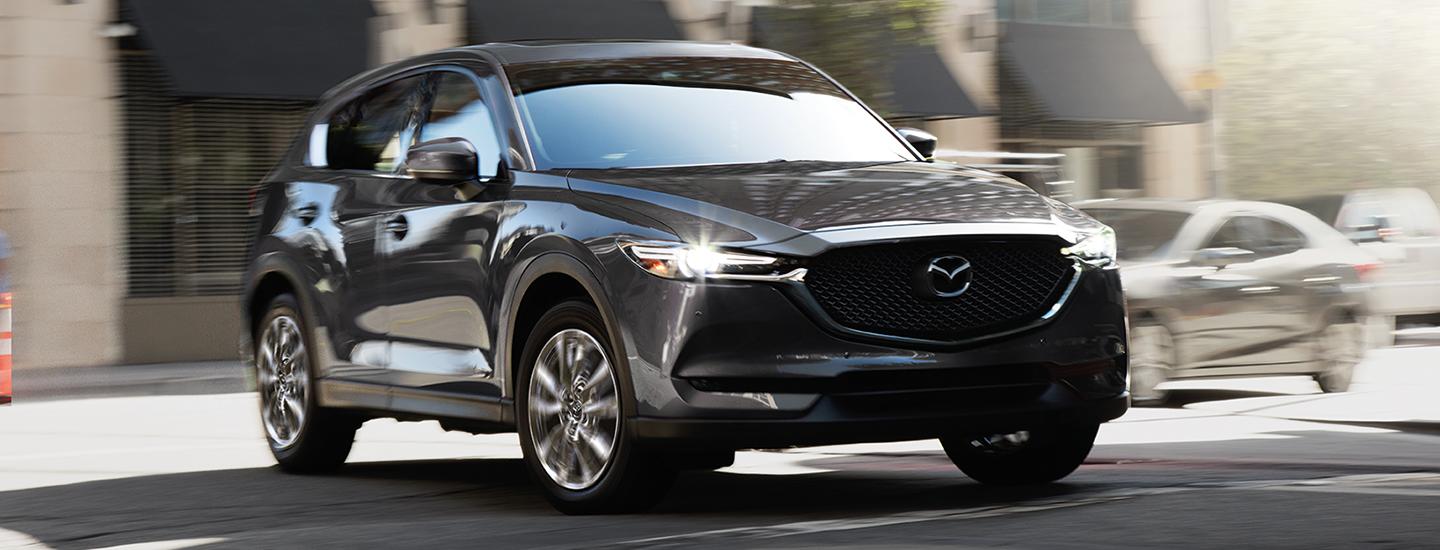As a cyclist, my bike is likely my most valued possession. When I’m riding on the trail, all of life’s worries seem to disappear, but transporting it there is a whole different story.
Why? I constantly worry about a potential accident that could damage my beloved bike or, even worse, leave it completely ruined.
When I use a hitch-mount rack, I worry that a distracted driver could rear-end me and crush my bike. If I opt for a roof rack, it leaves my bike vulnerable to low-hanging obstacles and the possibility of hitting a garage roof.
Storing it in a pickup truck bed comes with the risk of theft if I need to stop for a quick errand. That’s why I prefer driving an SUV with fold-flat seats when transporting my bike.
An SUV with back seats that fold flat is incredibly practical. Whether you’re hauling sports equipment, luggage, or just about anything else, folding the rear seats down makes it all fit.
The great news is that there are plenty of SUVs with fold-down seats available today. Here are 10 excellent options.
1. 2020 Kia Telluride
The 2020 Kia Telluride, our winner for SUV of the Year, makes it incredibly simple to fold down the back seats. Just pull the straps on the back of the third-row seats, and they’ll drop down.
After that, press the standard one-touch fold button located in the rear cargo area to activate the folding of the second row.
Within moments, the Telluride’s cargo space expands from the standard 21 cubic feet to a generous 87 cubic feet when the seats are folded down.
The 2020 Kia Telluride is a significant model for Kia, marking its largest vehicle to date and stepping into the three-row SUV market with impressive features.
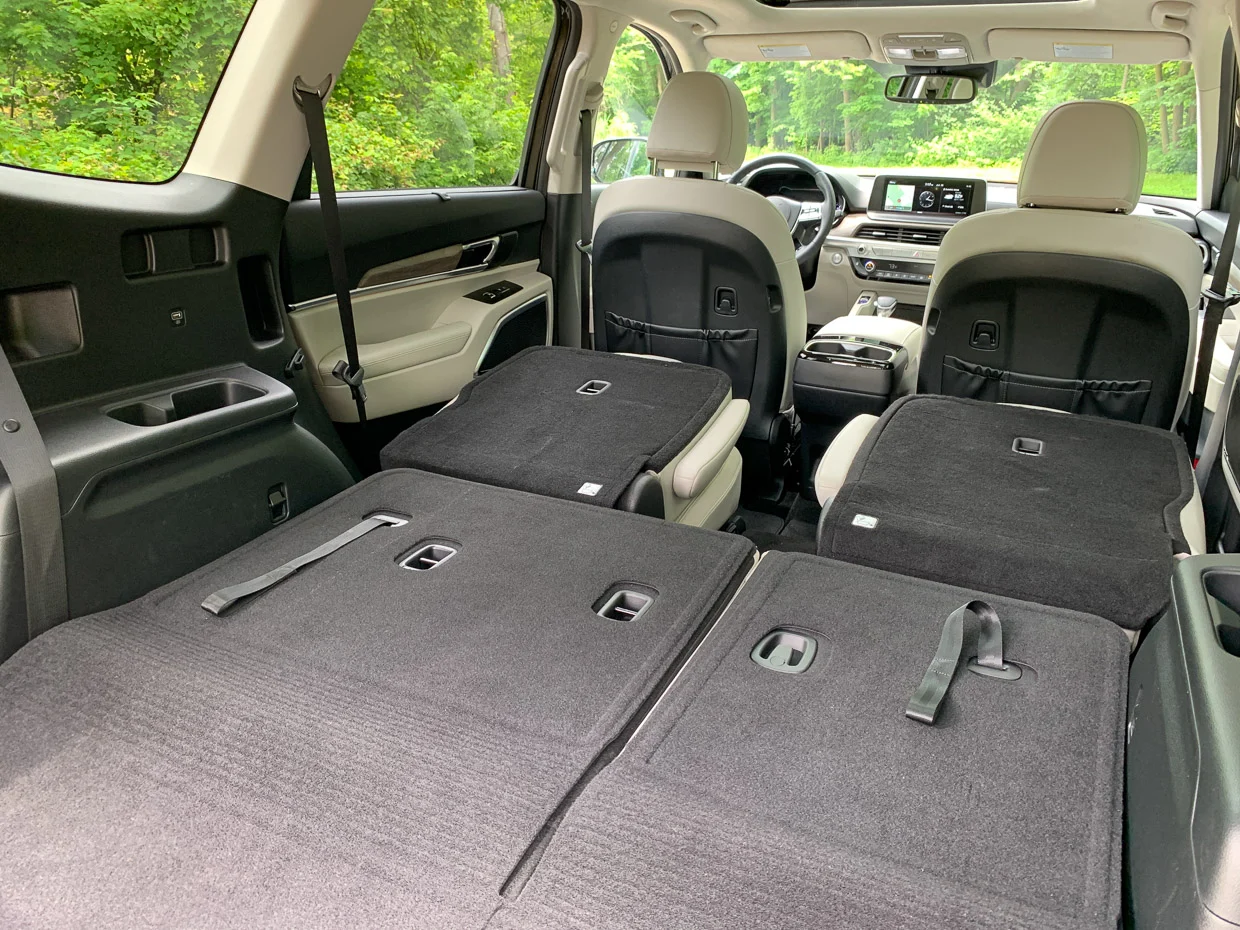
The Kia Telluride boasts a number of advantages, including a robust standard V6 engine offering decent towing power, a spacious interior perfect for large families, and an abundance of standard tech and safety features. It also provides a plush ride and well-shaped seats for all-day comfort.
However, it does have some drawbacks: it lacks available powertrain upgrades and offers less small-item storage space in the cabin compared to some competitors.
This all-new model, Kia’s biggest SUV, seats seven or eight passengers and offers up to 87 cubic feet of cargo capacity, making it a substantial upgrade from Kia’s Sorento. It comes with a 291-horsepower V6 engine, along with a suite of advanced driver assistance features.
The interior is upscale, offering family-friendly features like an available driver intercom system, and the Telluride stands out with its bold styling, a rarity in its class. Kia has carefully designed the Telluride to ensure it drives well, provides ample utility, and offers a pleasant and comfortable passenger experience.
In higher trims, it becomes a near-luxury option, delivering an even more premium experience. As a result, the Telluride has quickly become one of the top models for those shopping for a three-row crossover SUV.
2. 2020 Subaru Outback
Subaru’s highly popular pseudo-SUV is built to be the ultimate adventure vehicle, and folding back seats are a key part of its design.
Levers located in the cargo area allow you to easily release the second-row seats, increasing the cargo space from 32.5 cubic feet to 75.7 cubic feet.
For its latest generation, Subaru has made an effort to expand the space behind the fold-flat seats, allowing for even more gear to be loaded in.
After driving 2,000 miles in a car, you really start to understand its strengths and areas for improvement. This was certainly the case with our 2020 Subaru Outback Onyx long-term test car, which senior copy editor Jesse Bishop took on a road trip from Los Angeles to Colorado and back.
The trip tested the turbocharged Subaru in a variety of conditions, including long highway stretches, stop-and-go traffic, and slow off-road trails—exactly the types of scenarios you might encounter in a 2020 or 2021 Outback. Here are five of Bishop’s impressions from the extended road trip in the Outback Onyx.
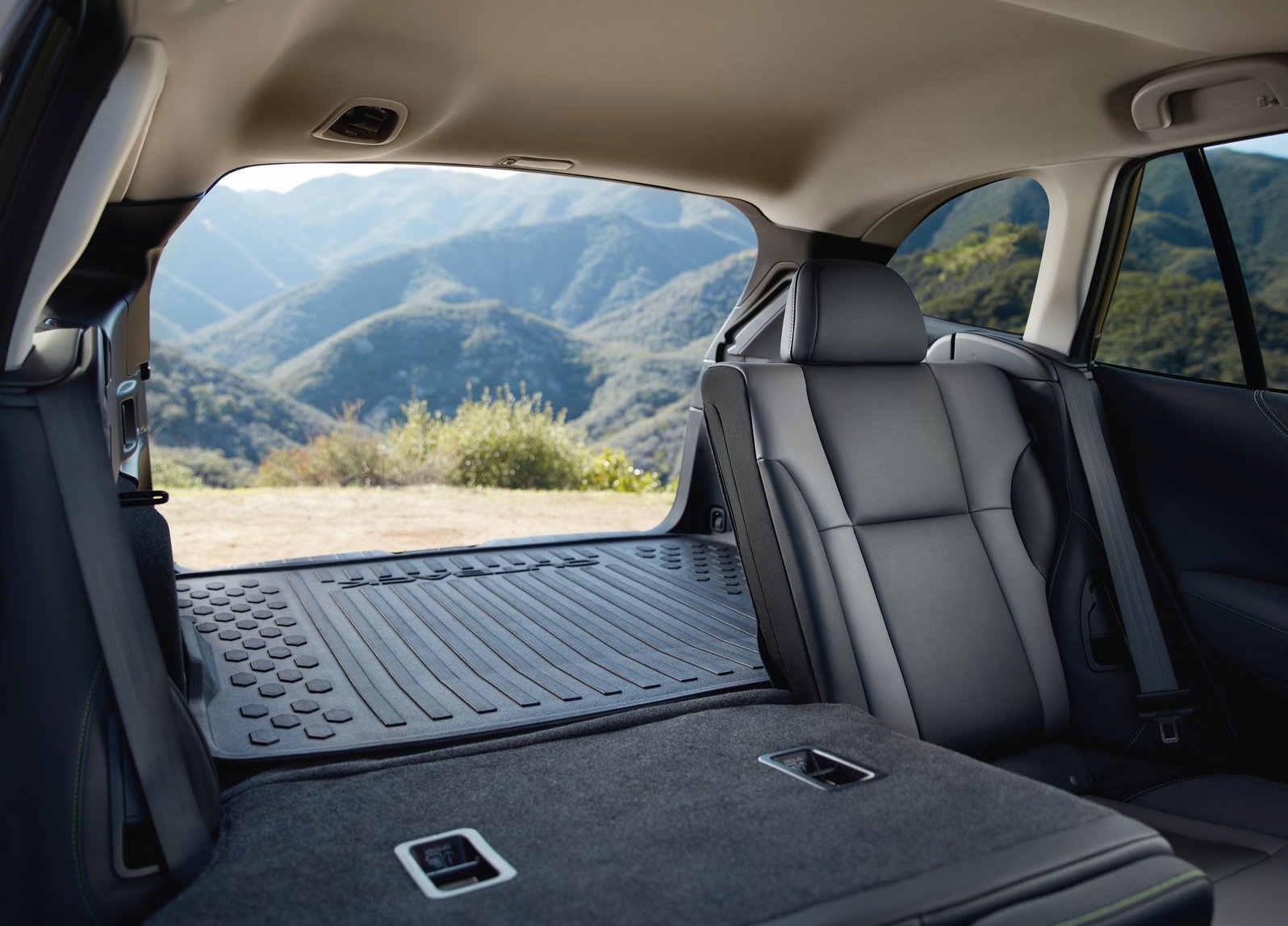
The Outback’s ride quality was one of the standout features. On the way to Colorado, the original plan was to drive until we reached Utah and camp overnight. However, we got a late start from Los Angeles, and by the time we arrived in Utah, it was already dark and the temperature was still over 90 degrees Fahrenheit.
Instead of searching for a campsite in the dark and dealing with the heat, we decided to keep driving straight through to our destination. We only stopped a few times for gas, and the total trip took about 17 hours.
Normally, I would have given up after half that time, but the Outback’s comfort made it possible to keep going. Perhaps months of working from home, barely moving except from my chair to the couch, helped prepare me for this endurance.
The 2020 Outback continues Subaru’s tradition of offering a smooth and comfortable ride, which has become a core value for the brand.
The Outback can make even the roughest potholes feel like small road imperfections, though this comfort comes with a slight floatiness. However, given that the Outback isn’t marketed as a sporty vehicle, I consider the tradeoff to be worth it.
Another impressive feature was the Outback’s adaptive cruise control, which worked seamlessly once I trusted it. The system is capable of bringing the car to a complete stop, though if traffic halts for more than a few seconds, I have to reactivate it to get the car moving again.
On the way to Colorado, we encountered a stretch of I-15 where construction narrowed traffic to a single lane, and we crawled at a pace of about a mile per hour.
Initially, I struggled to trust the system in such stop-and-go traffic, which made the experience frustrating. However, on the way back, I had gained more confidence in the technology.
The difference was noticeable, and I was much more comfortable not having to constantly adjust the brakes in that situation. The system’s constant beeping as it detected cars in front of me became more of a background noise that I hardly noticed.
I completely agree with the convenience of adaptive cruise control systems, especially in difficult traffic situations. I’ve even used one in the stop-and-go traffic of a busy Disneyland parking lot.
What would make the Outback’s system even more helpful is the ability to adjust the settings, particularly the levels of accelerative aggressiveness. I plan to test out this feature to see if I can customize the desired following distance and aggressiveness level to meet my standards for an ideal adaptive cruise control experience.
Also Read: 11 Foreign Car Brands Building Their Best Vehicles in America
3. 2020 BMW X7
This seven-seat BMW SUV is loaded with features, including back seats that fold down for added convenience. A button in the cargo area allows you to maximize the vehicle’s cargo capacity by folding down the second and third-row seats with just one touch.
Press it again, and voila! all the seats rise back up. However, it’s important to note that the X7’s second-row seats take a bit of time to fold down and don’t lay perfectly flat.
Despite this, the SUV offers up to 90.4 cubic feet of cargo space, providing ample room for a substantial amount of gear in this luxury vehicle.
Luxury and decadence were the driving factors behind our decision to add BMW’s largest SUV, the X7, to our long-term fleet. While we could have chosen the six-cylinder xDrive40i model, we opted for the more powerful 523-hp M50i V-8 version.
Though the 2021 Alpina XB7 now sits above the M50i in the lineup, the M50i still holds its own as a special vehicle, and we were eager to see how its high-tech luxury would hold up after 40,000 miles of driving.
We also wanted to evaluate how effectively BMW’s largest SUV could serve as a three-row alternative to the brand’s luxurious 7-series sedan. As we soon discovered, the X7 M50i did this role exceptionally well, though not without a few imperfections.

Our test car, with an as-tested price of $113,845 (base price of $100,595), came loaded with options. We particularly appreciated the $3400 Bowers & Wilkins audio system and the $3450 Dynamic Handling package. The latter enhanced agility with rear-axle steering and included technology that scans the road ahead for bumps, adjusting the adaptive dampers accordingly.
The Pirelli P Zero PZ4 tires, an upgrade from the standard all-seasons on 21-inch wheels, also contributed to improved handling and better grip. When snow began to fall, we swapped out the stunning 22-inch M wheels and P Zeros for a $3045 set of Bridgestone Blizzak DM-V2 tires mounted on 20-inch OZ Racing Cortina wheels.
The combination of winter tires, standard all-wheel drive, and the 553 pound-feet of torque from the twin-turbo V-8 made it easy to power through deep snow with the 5742-pound M50i.
For winter convenience, the X7 also featured the $1200 Cold Weather package, which included five-zone automatic climate control, heated front armrests, heated rear seats, and a heated steering wheel in addition to the standard heated front seats.
Our X7 M50i performed best with its sporty 22-inch M wheels and the robust Pirelli P Zero PZ4 summer tires, which come standard on the M50i.
Highs of the X7 M50i included its sonorous and powerful V-8 engine, the whisper-quiet cabin, and its refined cruising manners.
Other options in our X7, such as the $1300 Executive package, were considered a bit excessive by some. This package included features like heated and cooled cupholders, a cut-glass shifter, an iDrive controller, and an illuminated start-button bezel, along with a panoramic sunroof that was LED-lit. Some complaints arose over the cupholders, as they didn’t seem to make much difference to the temperature of our beverages.
The glass controls, while visually appealing, could occasionally be distracting when the sunlight reflected off them and into our eyes. As for the illuminated sunroof, while it matched the luxurious nature of the vehicle, it was hard to fully appreciate from behind the steering wheel.
Another addition we could have done without was the $1700 Driver Assistance Professional package. We often found ourselves deactivating its driver aids, primarily due to the nagging nature of BMW’s hands-free system, which repeatedly asked us to place our hands back on the steering wheel, even when we already had them there.
One feature we did wish our X7 had was the $550 factory-installed trailer hitch, which adds a towing mode that adjusts the powertrain and driver-assist features for trailer use.
Since BMW doesn’t offer the factory hitch once the vehicle leaves the factory, we opted for an aftermarket \$967 Stealth Hitch. This clever hideaway hitch allowed us to take full advantage of the X7’s 7500-pound towing capacity.
After testing the X7’s towing capabilities, testing director Dave VanderWerp praised the SUV’s performance. “It hauled the roughly 5800-pound trailer and car with ease, even at 75-to-80-mph cruising speeds,” he said.
With the car in tow, the X7 averaged 14 mpg, compared to 21 mpg on the 2100-mile journey without the trailer. Over the course of its time with us, the X7 achieved an overall fuel economy of 17 mpg, which matches the EPA’s combined rating for the vehicle.
4. 2020 Mazda CX-5
The Mazda CX-5 stands out for its stylish design and enjoyable driving experience. This SUV also offers impressive practicality, thanks to its fold-flat seats.
It features a 40:20:40 folding second-row seat, allowing for flexible configurations. You can fold down the left, right, or middle seat individually, or flatten the entire back seat.
This increases the cargo space from 30.9 cubic feet to 59.6 cubic feet. Pack up some duffel bags and hit the road with ease. The 2020 Mazda CX-5, a standout in the small crossover SUV category, combines style, performance, and practicality in a way that sets it apart from many of its competitors.
With a sleek design inside and out, the CX-5 looks more upscale than many rivals, offering a driving experience that’s both engaging and sporty. This is particularly appealing to those who want a crossover that’s not just practical, but also fun to drive.
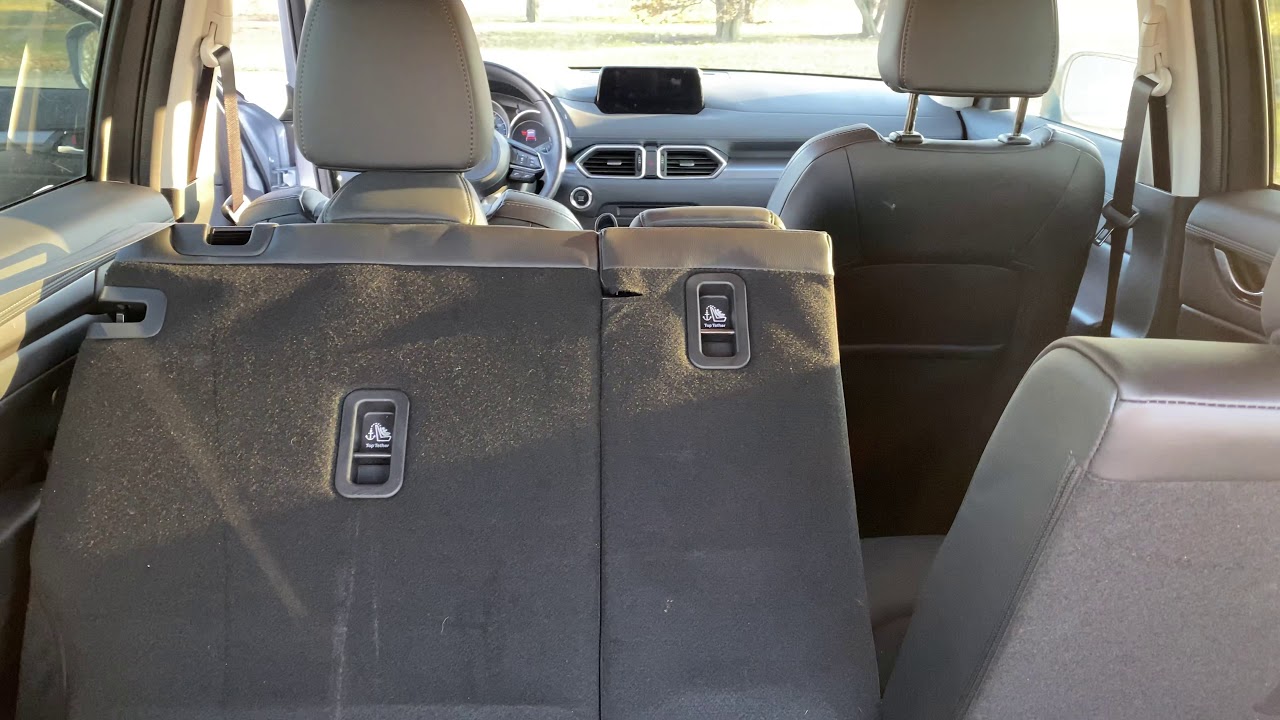
The CX-5 ties with the Honda CR-V, though the CR-V edges out the Mazda in terms of practicality. However, the CX-5 has the advantage when it comes to driving dynamics and performance potential, particularly when equipped with the optional turbocharged engine.
While the CX-5 excels in many areas, it does have a few drawbacks. The base engine, though adequate, doesn’t provide the acceleration many would expect in this class.
Additionally, rear legroom and cargo capacity are smaller compared to many of its rivals, which may limit its appeal to buyers needing more space. Despite these limitations, the CX-5 remains an excellent choice for those seeking a well-rounded, enjoyable-to-drive SUV.
For those curious about the day-to-day experience, the 2020 CX-5 is slightly different from the 2018 model we tested long-term, notably with the addition of the optional turbocharged engine and the introduction of Android Auto and Apple CarPlay in 2019.
However, much of the ownership experience remains the same, including its reputation for fun driving and stylish design, making it a strong contender in the competitive small SUV market.
5. 2020 Honda CR-V
The Honda CR-V is a pioneer in the compact SUV category and continues to improve with each iteration. Its back seats fold down flat, offering a total of 75.8 cubic feet of cargo space.
The 2020 Honda CR-V Hybrid maintains this same interior volume, as it doesn’t sacrifice any space despite the addition of the battery pack.
Honda consistently stands out as a leader in the automotive industry, known for building all-around excellent vehicles. Their models are typically more enjoyable to drive, fuel-efficient, spacious, and of higher quality than most rivals.
This philosophy is embodied in the Honda CR-V, a crossover that has been a top seller in America for over 20 years. Competing in the heart of the crossover market, the CR-V faces off against popular models like the Nissan Rogue and Volkswagen Tiguan.
Despite tough competition, the CR-V remains a sales leader, admired for its comfortable accommodations, excellent crash-test scores, spacious cargo hold, and high-quality cabin. However, there are some downsides, including an outdated infotainment system, weak CVT performance, and a grumbly engine.
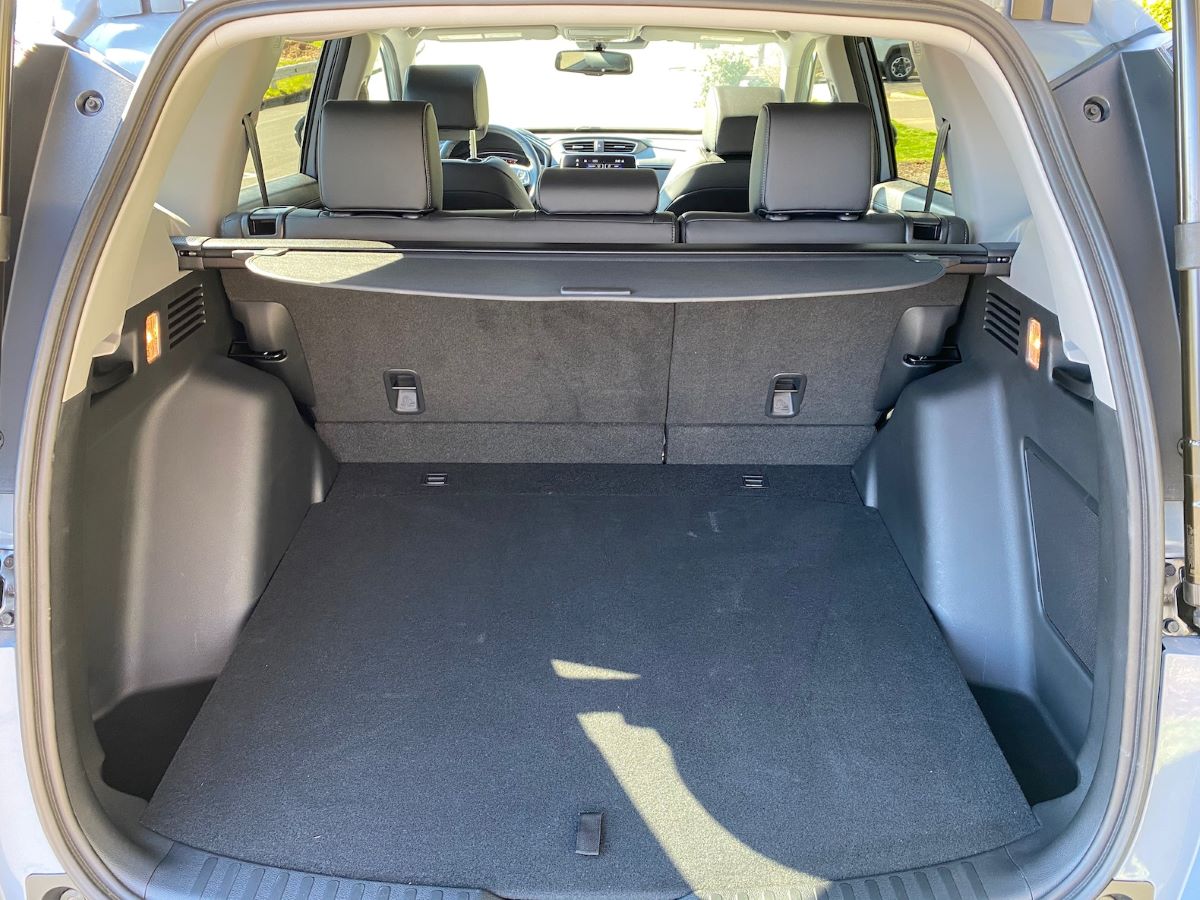
For the 2020 model year, Honda introduced several improvements to keep the CR-V competitive against newer entries like the Toyota RAV4 and Ford Escape. The price of the base LX model only increased slightly, by $600, while significant upgrades were made in technology and features.
Notably, Honda Sensing, the automaker’s suite of advanced driver-assistance technologies, is now standard across all CR-V models. This suite includes lane-keeping assist, forward collision warning, road departure mitigation, and adaptive cruise control, enhancing safety and convenience.
Another key update is the change under the hood: the previous 2.4-liter I4 engine has been replaced by a turbocharged 1.5-liter four-cylinder engine across all models, producing 190 horsepower and 179 pound-feet of torque.
Paired with a continuously variable transmission (CVT), the CR-V offers front-wheel and all-wheel drive configurations across various trim levels, from the LX and EX to the fully loaded Touring trim.
Visually, the 2020 CR-V also received some subtle updates. It now features new headlights, reworked front and rear bumpers, fresh wheel designs, and three new exterior paint colors, including the eye-catching Aegean Blue.
This metallic hue, which was featured on the test vehicle, stands out even on a cloudy winter day, giving the CR-V a sharp and distinctive appearance.
In terms of practicality, Honda’s clever engineering allows the CR-V to offer more cargo space than many of its rivals. With over 39 cubic feet of cargo space behind the second-row seats, the CR-V’s low floor design makes the space feel even more expansive.
When the rear seats are folded down, cargo capacity expands to nearly 76 cubic feet, surpassing that of the Escape, Tiguan, and RAV4. For added convenience, the 60/40-split rear seat can be folded using handles on the backrests or levers in the cargo area, simplifying the process of maximizing storage space.
The CR-V is equally impressive when it comes to passenger comfort. The seats in the Touring trim are covered in high-quality leather, which is a pleasant surprise for this segment, although the interior feels a bit dark due to the all-black theme.
While this color scheme is exclusive to the Aegean Blue exterior, buyers can opt for a lighter gray interior with other paint options.
Honda’s front seats are typically hit or miss, but in this case, they are more comfortable than expected, offering ample support. The backseat provides enough space for all but the tallest passengers, although the bottom cushion could be positioned slightly higher for better comfort.
Inside the cabin, the CR-V sets itself apart from many competitors with its well-crafted interior. The materials are smartly grained, and the build quality is exceptional.
Everything fits together securely, with nothing feeling loose or flimsy, except for the mechanical shifter, which feels a bit sloppy and unsatisfying in its operation. Honda has thoughtfully used soft-touch plastics on areas frequently touched by passengers, such as the middle armrest and the upper sections of the door panels.
Some sections even feature molded faux stitching, though opinions may vary on whether this is a charming touch or an unnecessary attempt at faux luxury. Overall, the CR-V’s interior stands out for its combination of quality materials, thoughtful design, and attention to detail.
Also Read: 13 Engines That Made Japanese Cars Unstoppable and Changed Performance Culture Forever
6. 2021 Chevrolet Suburban
The Chevrolet Suburban stands out among SUVs for its massive cargo capacity. It features second- and third-row seats that fold flat, providing ample space for everything from sports gear to family supplies.
With all seats in place, the 2021 Suburban offers 41.1 cubic feet of cargo space.
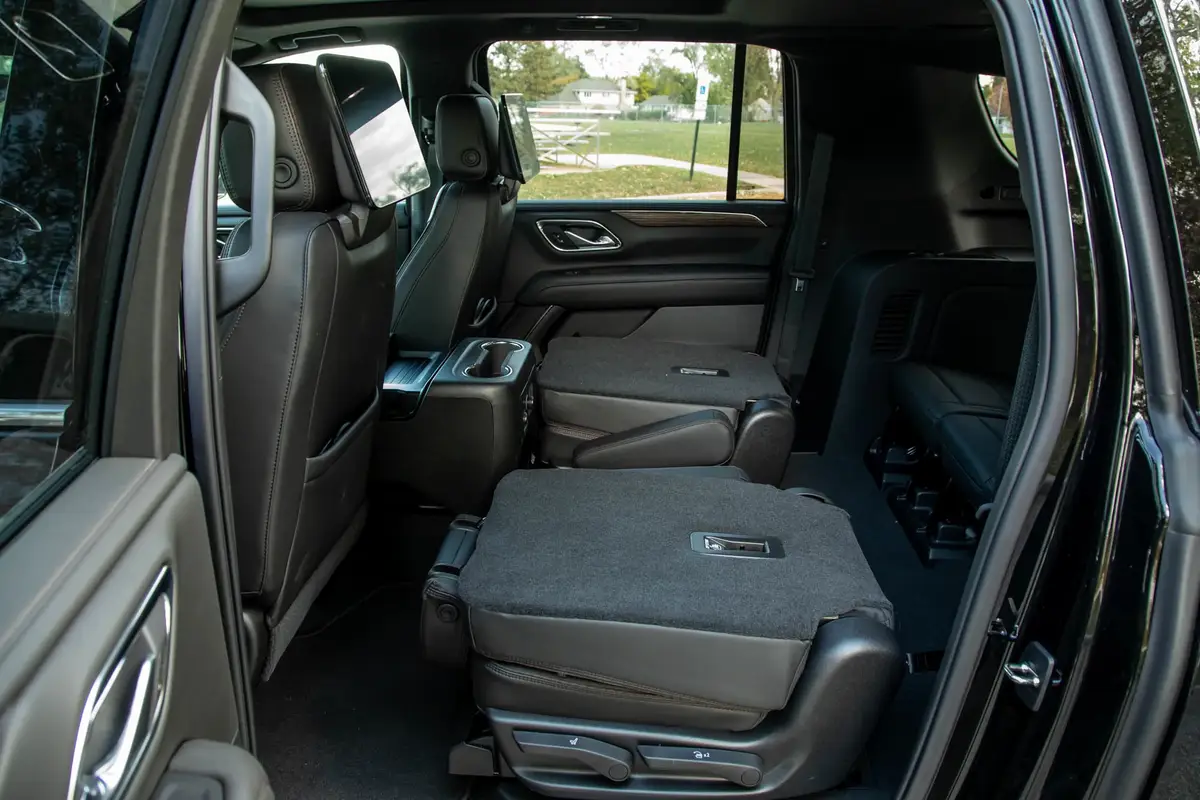
When you fold down both the second- and third-row seats, the cargo capacity expands to an impressive 144.7 cubic feet an increase of 23 cubic feet compared to the previous Suburban and rivaling the space found in some large city apartments.
7. 2020 Toyota Sequoia
The Toyota Sequoia ranks among the top SUVs when it comes to cargo space. Its second- and third-row seats fold flat, allowing for a maximum of 126.4 cubic feet of cargo capacity surpassing that of the Dodge Durango, Ford Expedition, Nissan Armada, and Chevrolet Tahoe.
This generous space is more than enough to accommodate even the largest pieces of gear and luggage. Toyota asserts that there’s enough room inside to fit items as long as 11 feet.
The 2020 Toyota Sequoia TRD Pro was the oldest model in this year’s test, as the other three vehicles were all-new. The Sequoia, however, has largely remained unchanged since the 2008 model year.
Its eligibility for the 2021 Four Wheeler SUV of the Year test comes from the inclusion of the TRD Pro off-road suspension package, which is designed for desert driving.
This package enhances the Sequoia with 2.5-inch Fox internal bypass shocks for the front and 2.0-inch Fox monotube shocks for the rear suspension. Additionally, the TRD Pro package includes foglights from Rigid Industries, 18×8-inch black forged BBS wheels, a robust front skid plate, and cast aluminum running boards.
Though the TRD Pro package became available late in 2020, it carried over into the 2021 Four Wheeler of the Year test. Due to its age, some of the judges were initially unsure of how the 2020 Toyota Sequoia would perform. However, these concerns were quickly alleviated as soon as testing began.
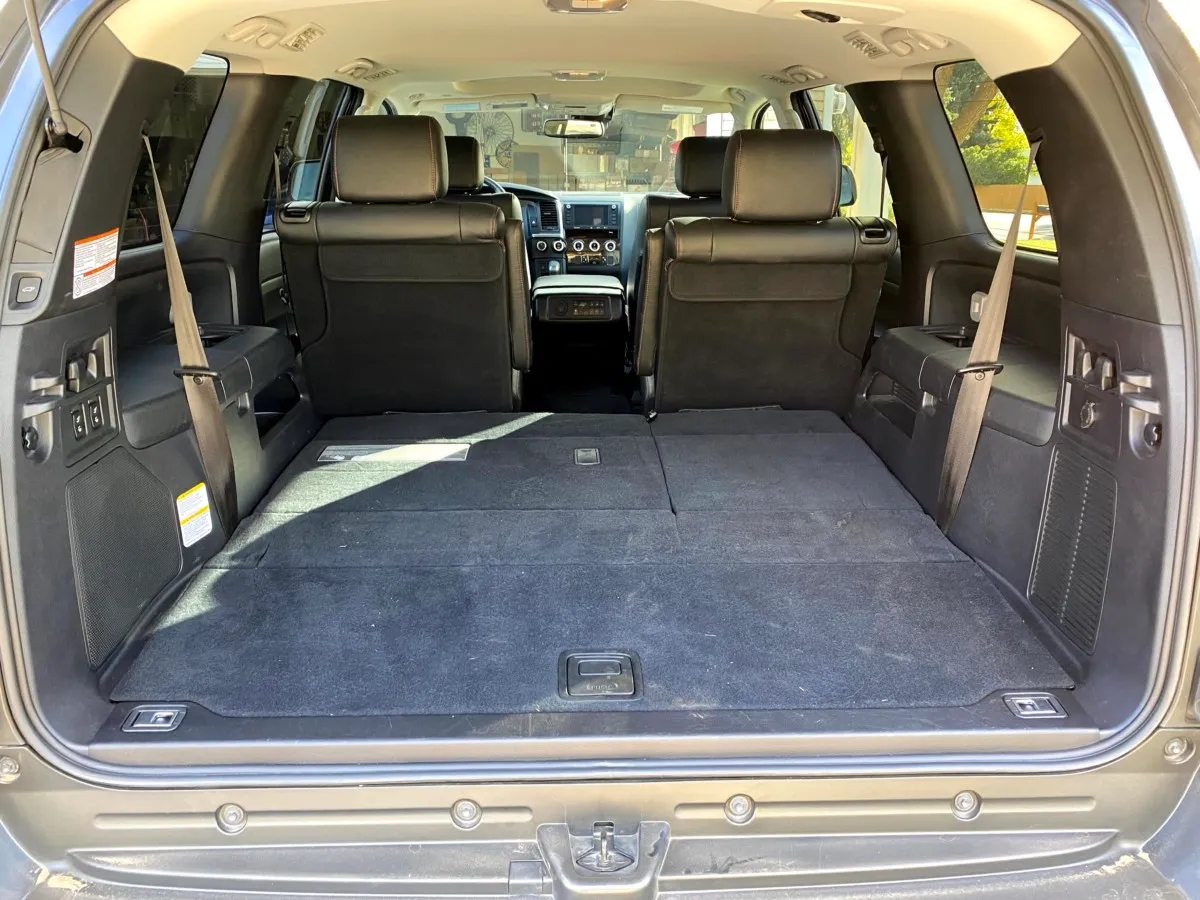
The 2020 Toyota Sequoia TRD Pro comes with a single engine and transmission option. The powertrain is led by Toyota’s reliable 5.7L iForce V-8 engine, which produces 381 horsepower and 401 lb-ft of torque.
This engine is paired with a six-speed automatic transmission, which, while basic by modern standards, provides solid performance. Four-wheel drive is standard for TRD Pro models, and it includes a center differential lock, although the axles remain open.
Despite being the heaviest vehicle in the test field, with an estimated curb weight of 5,985 pounds, the Sequoia TRD Pro was still able to perform impressively. It accelerated from 0 to 60 mph in just 7.23 seconds.
The full-size SUV also completed a quarter-mile in 15.65 seconds at 91.70 mph. The Sequoia’s braking performance was also notable, with the vehicle coming to a stop from 60 mph in 128.33 feet.
While the Sequoia TRD Pro was the only vehicle in the test not equipped with adjustable air suspension, it did come with a fully independent suspension system, similar to the other competitors.
On the 22-degree RTI ramp, the Sequoia was able to climb 47 inches before losing traction. This earned the Sequoia a score of 351.74, which, while not the highest, was still competitive within the group.
8. 2020 Ford Explorer
Nearly everyone has experienced a ride in a Ford Explorer at some point. For its latest generation, this SUV enhances its fold-flat seat functionality.
The second and third-row seats are optionally available with a feature that allows them to fold flat at the touch of a button in the cargo area a feature typically found in higher-end luxury SUVs.
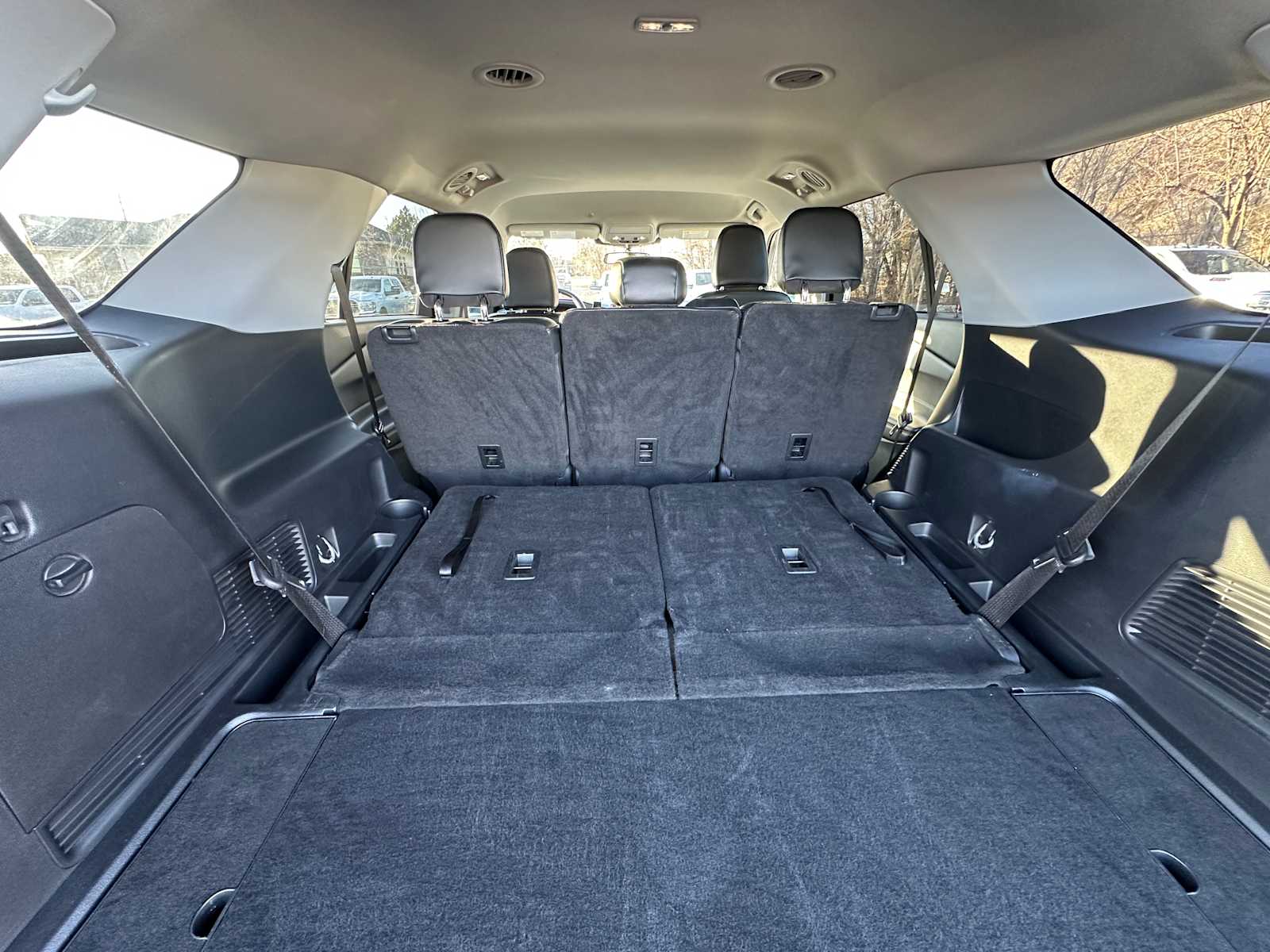
When all seats are in place, the Explorer offers 18.2 cubic feet of cargo space. However, when the fold-flat seats are lowered, the capacity expands to an impressive 87.8 cubic feet.
9. 2020 GMC Terrain
While it’s common for SUVs to offer fold-flat seats in the second and third rows, the GMC Terrain has a unique feature: its front-row passenger seat also folds flat.
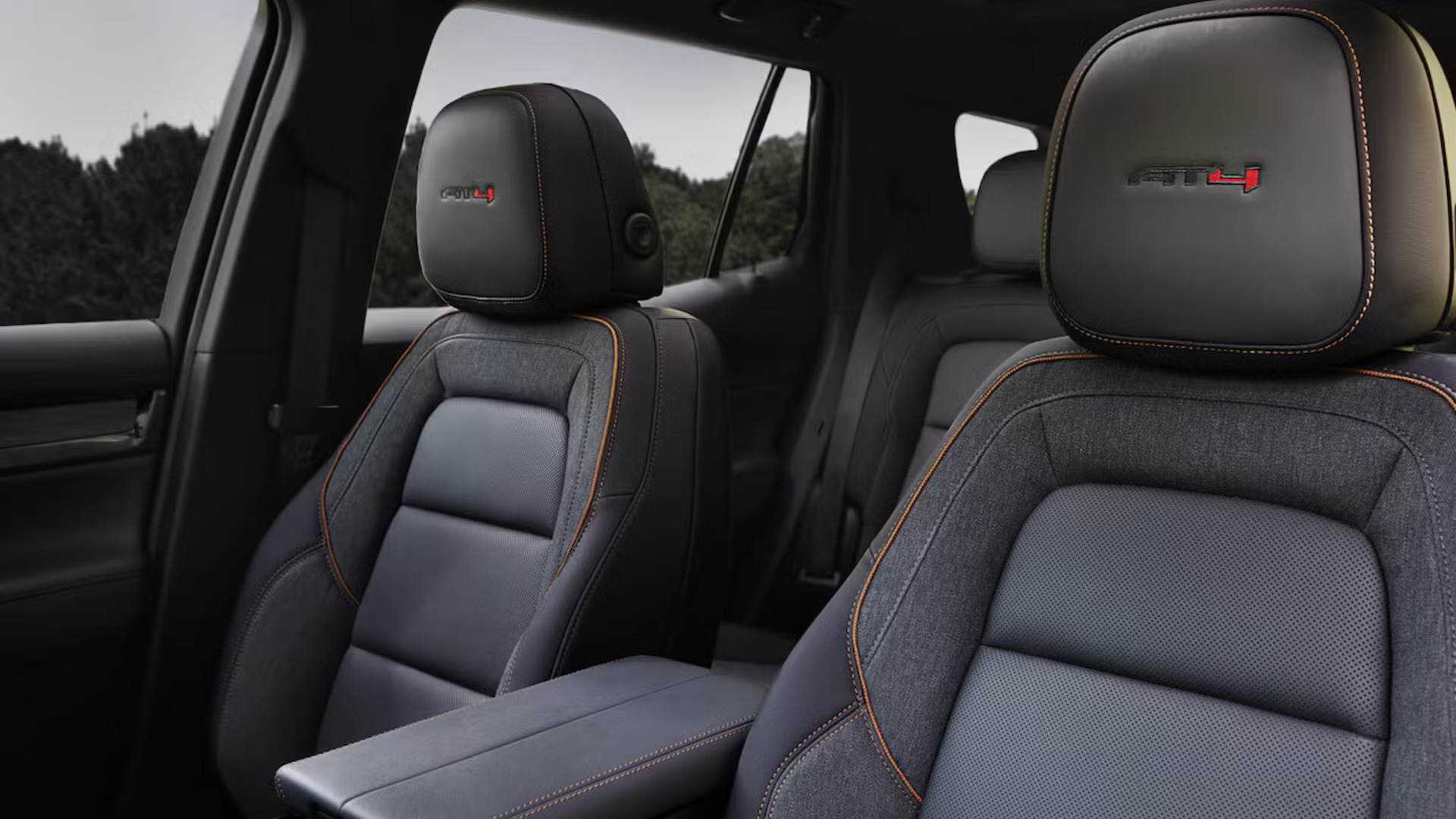
This allows drivers to fit extra-long items into the compact SUV, although it does mean sacrificing a co-pilot for the ride. In addition, the Terrain offers a total cargo volume of 63.3 cubic feet, thanks to the back seats that can also be folded flat.
10. 2020 Jeep Renegade
The Jeep Renegade, while being one of the smallest SUVs available, remains a tough and capable vehicle. It features back seats that fold down flat, adding to its practicality.
With the seats up, the Renegade offers 18.5 cubic feet of cargo space, which increases to 50.8 cubic feet when the seats are folded down. Pack your gear and head out on the trail.
The Jeep Renegade is a subcompact SUV and the smallest vehicle in Jeep’s lineup, introduced in the 2015 model year. Built on the same platform as the Fiat 500X and manufactured in Italy, the Renegade differs from Jeep’s iconic off-roaders by being based on a front-wheel-drive (FWD) architecture and designed primarily for urban use rather than heavy-duty off-roading.
However, it still carries the Jeep identity with the availability of all-wheel drive (AWD) and trail-ready features, ensuring it’s capable of light off-road tasks while maintaining the brand’s signature seven-slot grille.
For the 2020 model year, the Renegade features an updated telematics module that enhances wireless data connectivity across all models, as well as the availability of a new nine-speaker Kenwood premium audio system. Aside from these updates, previous optional equipment and packages have been reorganized and are now available on additional trim levels.
When it comes to off-roading, the Renegade performs adequately for its size. While it can’t match the true off-road capabilities of Jeep’s legendary Wrangler, it can easily handle gravel roads and mild terrain thanks to its decent ground clearance and available AWD system.
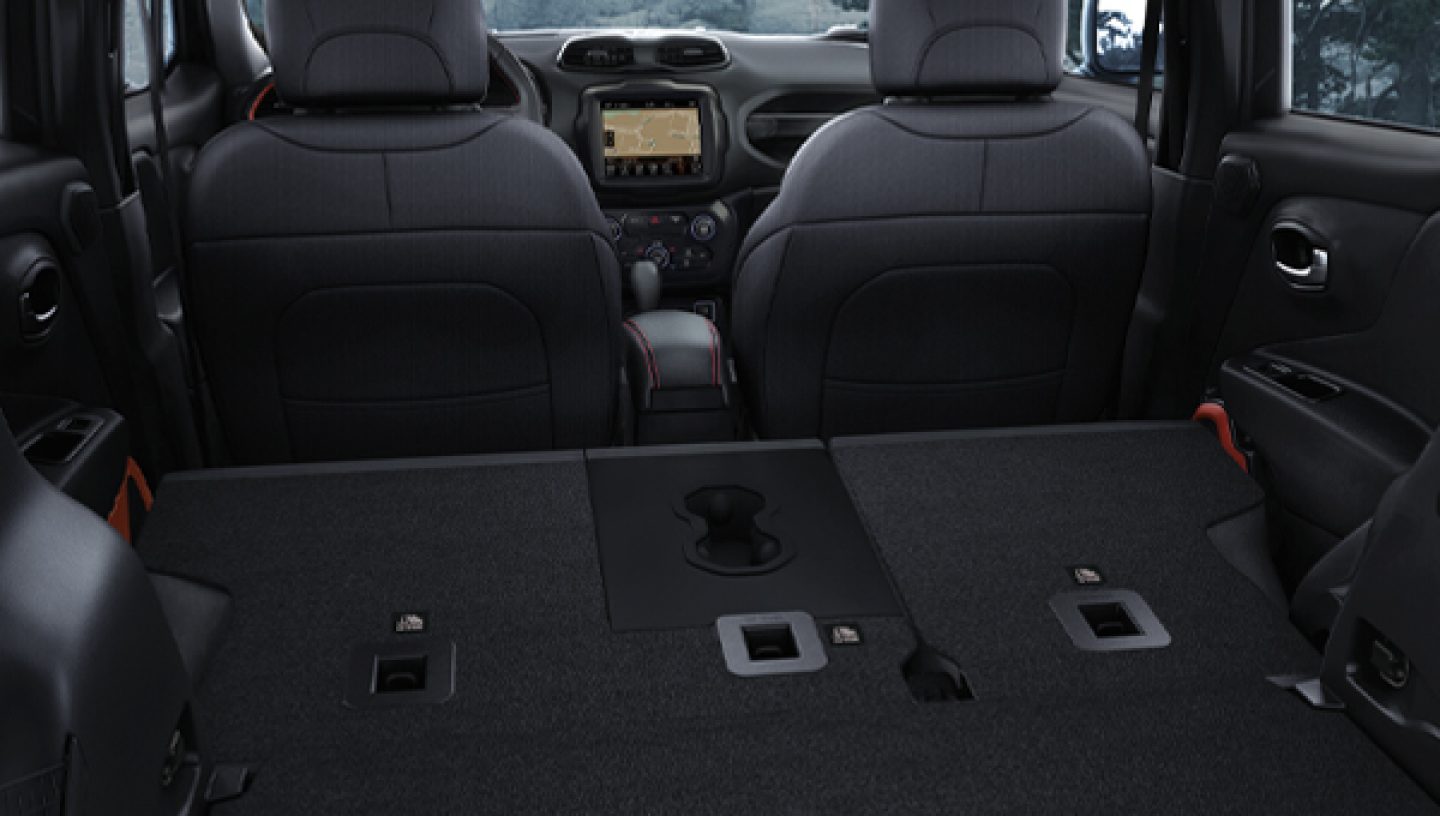
The Trailhawk trim further boosts off-road capabilities by adding several features aimed at improving rugged performance, although the AWD system must be manually engaged, and failure to do so can result in struggles on dirt paths. On pavement, the Renegade excels as a city vehicle, with its small size making parking and maneuvering easy.
The steering is responsive and accurate, though the ride can become less composed during sharp turns, with some body roll. Cargo capacity is generous, and the flat-folding front passenger seat helps accommodate longer items.
Additionally, visibility is excellent due to the upright windows and large side mirrors. The Renegade comes with FCA’s Uconnect infotainment system, which is intuitive, responsive, and easily syncs with smartphones.
However, despite its size, the Renegade struggles with acceleration. Both available four-cylinder engines lack performance, and the turbocharged I-4 is especially prone to noticeable lag.
The nine-speed automatic transmission doesn’t help matters, as it has been criticized for being overly complicated with more gears than necessary.
This results in sluggish responses and rough shifting through its uneven gear ratios. City fuel economy is also disappointing given the engine size, and the interior, though functional, is made from plastic materials that feel cheap and have some minor but frustrating issues.
In terms of performance and fuel economy, all Renegade models come equipped with a nine-speed automatic transmission, and front-wheel drive is standard, with AWD available on all trims except for the Upland, North Edition, and Trailhawk, where it comes standard. The base engine is a 2.4-liter I-4, producing 180 horsepower and 175 lb-ft of torque.
The fuel economy for this engine with front-wheel drive is EPA-rated at 22 mpg city and 30 mpg highway, with AWD versions losing one mpg in each category. In 2019, Jeep introduced a turbocharged 1.3-liter I-4 engine, producing 177 horsepower and 200 lb-ft of torque.
Tsting of a Renegade Trailhawk with this engine showed a 0-60 mph time of 8.9 seconds, while an AWD Renegade Limited did the same in 9.3 seconds. The fuel economy for this engine with front-wheel drive is 24 mpg city and 32 mpg highway, while AWD models are rated at 23 mpg city and 29 mpg highway.
The Trailhawk version, with its off-road tires and specialized equipment, has a rating of 22 mpg city and 27 mpg highway. Models with the 1.3-liter engine also feature active grille shutters to help improve aerodynamic efficiency.
Despite its fun design and appeal to those looking for off-road capabilities, the Renegade struggles in terms of drivetrain refinement and fuel economy, making its ruggedness less appealing when compared to other crossovers.

